

Contributor
- Topics: Archive
[sidebar]Rogerson Clematis Collection
Open dawn until dusk daily
Luscher Farm Park
125 Rosemont Road
West Linn, Oregon 97068[/sidebar]
Welcome to Luscher Farm in West Linn, Oregon, home of the Rogerson Clematis Collection. After a “journey of epic proportions” (link to FRCC history) today the collection is maintained and cared for by the Friends of the Rogerson Clematis Collection (FRCC), a non-profit organization whose mission is to promote and advance the joy of growing the genus Clematis through education and the preservation of the Rogerson Clematis Collection.
Join Linda Beutler, curator of the collection, as she shares the following photos and information about a small segment of this thriving and floriferous landscape dedicated to the Queen of Vines.

The Luscher Farmhouse first appeared on tax rolls in 1900. The original family lived here until around 1914 and established the original landscape surrounding the farmhouse. Today, plants in the Heirloom Garden surrounding the sturdy white home date from that pre-WWI era. Arctostaphylos ‘Howard McMinn’ anchors the top of the sunny Front Bank.

To the west the Luscher Farmhouse overlooks the Founder’s Garden, the Baltic Border, Old Poland beds, and in the foreground (seen here in early spring), the Beginner’s Garden beds featuring clematis recommended by the International Clematis Society for gardeners new to growing the genus.
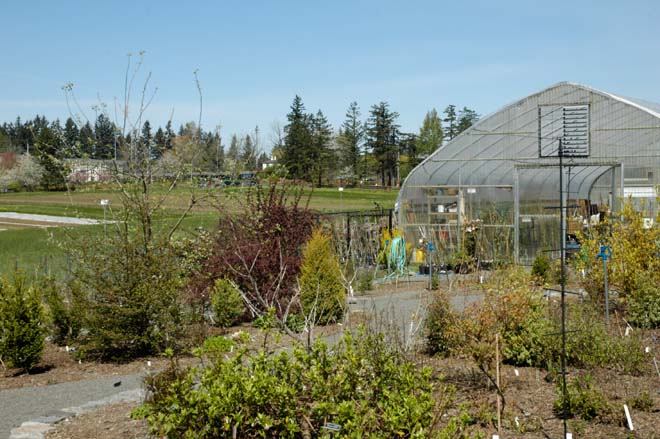
The Bob and Carol Gutmann Greenhouse was constructed for FRCC in the autumn of 2005. The entire collection, then numbering 900 plants in pots, was moved to the site on December 3, 2005. This view shows part of the 11.5 acres of 47th Avenue Farm CSA, which is another of the Luscher Farm Partners on the 43 acre site.
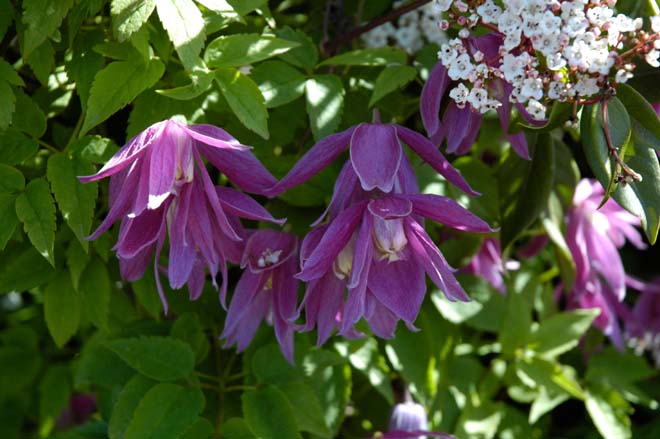
Clematis ‘Constance’ Alpina Group. Plants in the Atragene Group, including Clematis alpina, C. macropetala, and C. koreana and their hybrids, are some of the earliest to flower with excellent repeat. They need winter cold and good day-to-night temperature drops in the summer.
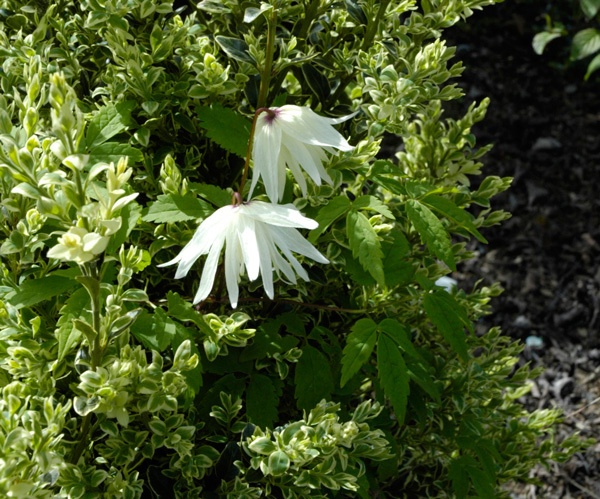
Clematis macropetala ‘Albina Plena’ is one of the plants chosen for the Founder’s Garden by Brewster Rogerson. The vine is very winter hardy as are most plants in the Atragene Group.

Clematis integrifolia ‘Caerulea’ (syn. Bushy Blue Bell from Monrovia) is an herbaceous perennial clematis that thrives in full sun on the Front Bank at Luscher Farm. Removing spent flowers keeps the plant blooming all summer. Here it’s deep violet-blue flowers appear alongside the yellow blossoms of × Halimiocistus wintonensis ‘Merrist Wood Cream’.
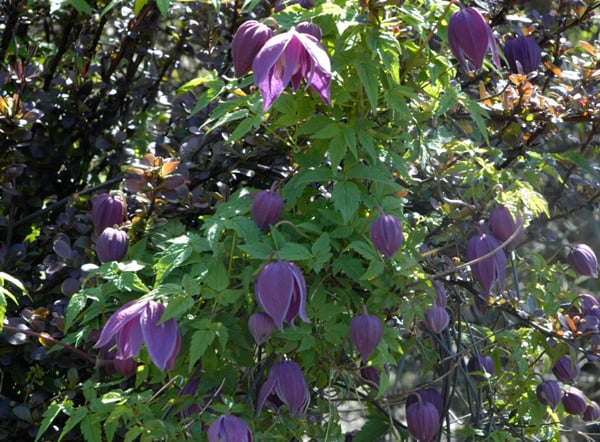
Clematis ‘Esprit’ is by far the most free-flowering clematis in the collection with flowers beginning in late March/early April and continuing until late September. This is a seedling selection, named by Brewster Rogerson, found growing in a pot of C. ‘Jacqueline du Pré’, an alpina cultivar and the presumed seed parent. Both are growing in the Founder’s Garden.
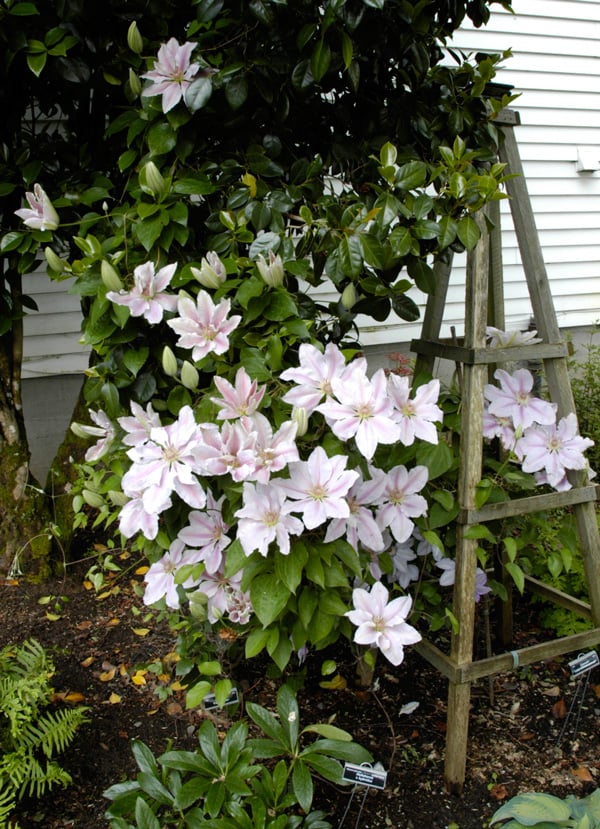
The large-flowered Clematis ‘Fairy Queen’ is an antique variety (1875) rarely seen in the trade. The spring flowers have been measured at 10 inches wide. This cultivar has good, though not as large, autumn flowers and may be seen growing in the Heirloom Garden.

Clematis ‘Kacper’, bred in Poland by Brother Stefan Franczak, blooms in spring when the cream and green foliage of Caryopteris ‘Summer Sorbet’ is leafing out with a repeat bloom in August when the Caryopteris flowers. You’ll find this combination in our Old Poland bed.
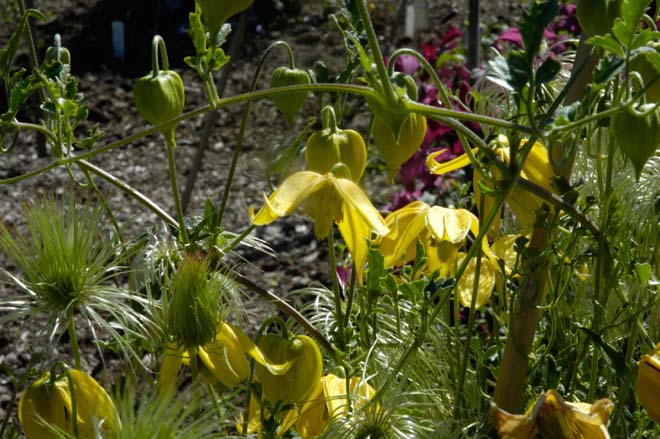
Clematis ‘Lambton Park’ is in the Tangutica/Orientalis group, and flowers from early summer into the autumn. The blossoms have a distinctive coconut scent. You’ll find this easy-to-grow plant in the Beginner’s Garden.

Clematis ‘Pink Cameo’ is an American-bred large-flowered hybrid by Jim Van Laeken of Spring Valley Greenhouse in New York, 1995. The autumn bloom is even more prolific than the spring flowering (seen here). This, and other modern hybrids will be established in a new border on the east side of the farm in 2014.
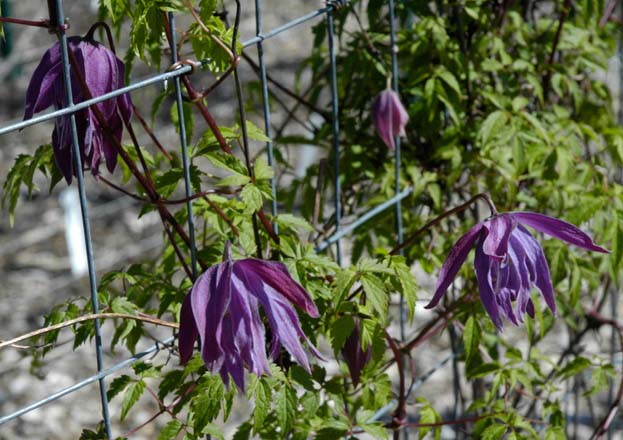
Clematis ‘Sparkle Plenty’ is an FRCC introduction from a seedling salvaged by Brewster Rogerson. It is distinctive in that the four outer sepals are darker and shorter than the inner double staminode sepals. Excellent late summer rebloom. You’ll find this beauty in the Test Garden.
Share:
Social Media
Garden Futurist Podcast
Most Popular
Videos
Topics
Related Posts

Low Maintenance Gardens – Better for Pollinators and People
Autumn 2022 “I come out every day. It’s therapy, my meditation.” Janet’s young garden transformed from overgrown, invasive plants to mostly natives. The dailiness of

Calochortophilia: A Californian’s Love Affair with a Genus
Summer 2022 I can chart the progression of my life by Calochortus. For the last two decades, at least. As a teenage girl growing up

Pacific Plant People: Carol Bornstein
Spring 2022 Public gardens play a key role in demonstrating naturalistic planting design, selecting native and adapted plants for habitat, and testing techniques for reducing

Add Year-Round Interest and Winter Blooms for Pollinators
Spring 2022 This article was created from an Interview by Merrill Jensen with Neil Bell in the Summer of 2021 for our Pacific Plant People

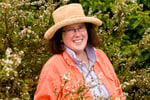







Responses